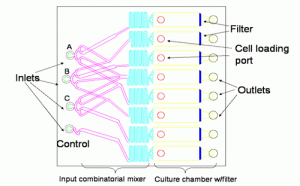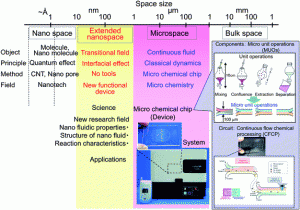Group Members: Erich Victor, Violet Guo
Today we will be discussing Chemical Analytics through micro and nanofluidics. To start off we’ll discuss the origins of microfluidic technology and how the process of chemical analysis was moved from a costly lab process to a fast and inexpensive method than can be done in the palm of your hand. After that we’ll move onto the inner workings of the device and soft lithography, one of the methods used to create microfluidic chips. Finally we’ll leave off with some of common applications for this technology, one of the issues scientists are trying to deal with, and what the future has in store for micro and nanofluidic analytic technology.


I thought this podcast was fairly well done. It was interesting to learn a little more about the origins of the microfluidic and nanofluidic chips, and to hear even more about their practical applications. Overall, the podcast was well produced, and I learned even more than what was covered in class.
This podcast does a very good job at accomplishing the goal of the entire project: explaining information to allow the listener to articulate thoughts. The way the information was presented was done in a clear, methodical process. On top of that, the information presented was given application which is one of the most crucial parts about educating a general public. If I hadn’t taken the ES101 course and listened to this, I would be able to pick up a thing or two about microfluidics. Very well done podcast.
This enlightened me about the history of microfluidic research and the challenges associated with it today. A low cost, portable, robust laboratory would be extremely useful for field research and medicine in remote areas. Good job.
This podcast does a good job of going over a brief history of the topic. Also, the explanation of soft lithography would be helpful to someone unfamiliar with the topic. You did a good job talking about the challenges that are faced by scientists using this technology today and speculating on what implications the topic could have in the future.
I really liked how in depth the background and history of this technology was. It was interesting to hear about how it has come from its first applications. In regards to the problems with nanofluidic flow in chips, did your group find anything about possible solutions or reasons for this difficulty in your research; I would like to learn about how possible plans or time frames until this technology could be readily available.
We were able to find a variety of information on nanofludics but the issues found was that many of the articles went into details we didn’t understand so it seemed odd for us to talk about those details. The most general ideas we could find was that it’s very complicated and how researchers are developing technologies specific to helping nanofluidic research such as tracer elements that would help with analyzing flow
The detailed description of both the background and the current technologies was very enlightening. Describing the problems was well done, and the projection into the future made it easy to see where the technology could go. Thank you.